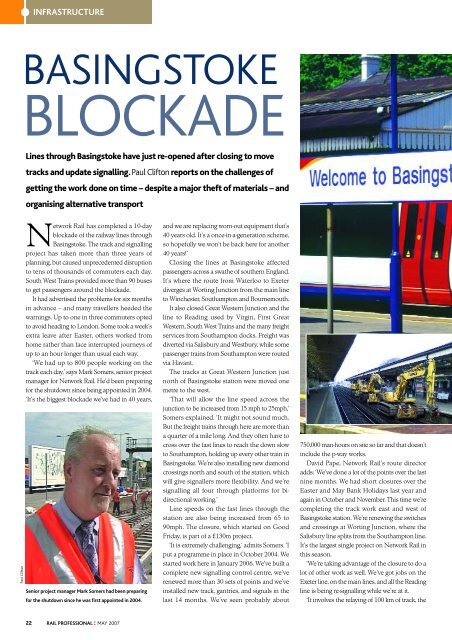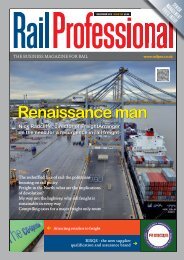move over freightliner, we want to get into ... - Rail Professional
move over freightliner, we want to get into ... - Rail Professional
move over freightliner, we want to get into ... - Rail Professional
You also want an ePaper? Increase the reach of your titles
YUMPU automatically turns print PDFs into web optimized ePapers that Google loves.
INFRASTRUCTURE<br />
BASINGSTOKE<br />
BLOCKADE<br />
Lines through Basings<strong>to</strong>ke have just re-opened after closing <strong>to</strong> <strong>move</strong><br />
tracks and update signalling.Paul Clif<strong>to</strong>n reports on the challenges of<br />
<strong>get</strong>ting the work done on time – despite a major theft of materials – and<br />
organising alternative transport<br />
Paul Clif<strong>to</strong>n<br />
Network <strong>Rail</strong> has completed a 10-day<br />
blockade of the railway lines through<br />
Basings<strong>to</strong>ke. The track and signalling<br />
project has taken more than three years of<br />
planning, but caused unprecedented disruption<br />
<strong>to</strong> tens of thousands of commuters each day.<br />
South West Trains provided more than 90 buses<br />
<strong>to</strong> <strong>get</strong> passengers around the blockade.<br />
It had advertised the problems for six months<br />
in advance – and many travellers heeded the<br />
warnings. Up <strong>to</strong> one in three commuters opted<br />
<strong>to</strong> avoid heading <strong>to</strong> London. Some <strong>to</strong>ok a <strong>we</strong>ek’s<br />
extra leave after Easter, others worked from<br />
home rather than face interrupted journeys of<br />
up <strong>to</strong> an hour longer than usual each way.<br />
‘We had up <strong>to</strong> 800 people working on the<br />
track each day,’ says Mark Somers, senior project<br />
manager for Network <strong>Rail</strong>. He’d been preparing<br />
for the shutdown since being appointed in 2004.<br />
‘It’s the biggest blockade <strong>we</strong>’ve had in 40 years,<br />
Senior project manager Mark Somers had been preparing<br />
for the shutdown since he was first appointed in 2004.<br />
and <strong>we</strong> are replacing worn-out equipment that’s<br />
40 years old. It’s a once-in-a-generation scheme,<br />
so hopefully <strong>we</strong> won’t be back here for another<br />
40 years!’<br />
Closing the lines at Basings<strong>to</strong>ke affected<br />
passengers across a swathe of southern England.<br />
It’s where the route from Waterloo <strong>to</strong> Exeter<br />
diverges at Worting Junction from the main line<br />
<strong>to</strong> Winchester, Southamp<strong>to</strong>n and Bournemouth.<br />
It also closed Great Western Junction and the<br />
line <strong>to</strong> Reading used by Virgin, First Great<br />
Western, South West Trains and the many freight<br />
services from Southamp<strong>to</strong>n docks. Freight was<br />
diverted via Salisbury and Westbury, while some<br />
passenger trains from Southamp<strong>to</strong>n <strong>we</strong>re routed<br />
via Havant.<br />
The tracks at Great Western Junction just<br />
north of Basings<strong>to</strong>ke station <strong>we</strong>re <strong>move</strong>d one<br />
metre <strong>to</strong> the <strong>we</strong>st.<br />
‘That will allow the line speed across the<br />
junction <strong>to</strong> be increased from 15 mph <strong>to</strong> 25mph,’<br />
Somers explained. ‘It might not sound much.<br />
But the freight trains through here are more than<br />
a quarter of a mile long. And they often have <strong>to</strong><br />
cross <strong>over</strong> the fast lines <strong>to</strong> reach the down slow<br />
<strong>to</strong> Southamp<strong>to</strong>n, holding up every other train in<br />
Basings<strong>to</strong>ke. We’re also installing new diamond<br />
crossings north and south of the station, which<br />
will give signallers more flexibility. And <strong>we</strong>’re<br />
signalling all four through platforms for bidirectional<br />
working.’<br />
Line speeds on the fast lines through the<br />
station are also being increased from 65 <strong>to</strong><br />
90mph. The closure, which started on Good<br />
Friday, is part of a £130m project.<br />
‘It is extremely challenging,’ admits Somers. ‘I<br />
put a programme in place in Oc<strong>to</strong>ber 2004. We<br />
started work here in January 2006. We’ve built a<br />
complete new signalling control centre, <strong>we</strong>’ve<br />
rene<strong>we</strong>d more than 30 sets of points and <strong>we</strong>’ve<br />
installed new track, gantries, and signals in the<br />
last 14 months. We’ve seen probably about<br />
750,000 man-hours on site so far and that doesn’t<br />
include the p-way works.<br />
David Pape, Network <strong>Rail</strong>’s route direc<strong>to</strong>r<br />
adds: ‘We’ve done a lot of the points <strong>over</strong> the last<br />
nine months. We had short closures <strong>over</strong> the<br />
Easter and May Bank Holidays last year and<br />
again in Oc<strong>to</strong>ber and November. This time <strong>we</strong>’re<br />
completing the track work east and <strong>we</strong>st of<br />
Basings<strong>to</strong>ke station. We’re renewing the switches<br />
and crossings at Worting Junction, where the<br />
Salisbury line splits from the Southamp<strong>to</strong>n line.<br />
It’s the largest single project on Network <strong>Rail</strong> in<br />
this season.<br />
‘We’re taking advantage of the closure <strong>to</strong> do a<br />
lot of other work as <strong>we</strong>ll. We’ve got jobs on the<br />
Exeter line, on the main lines, and all the Reading<br />
line is being re-signalling while <strong>we</strong>’re at it.<br />
‘It involves the relaying of 100 km of track, the<br />
22 RAIL PROFESSIONAL : MAY 2007

















